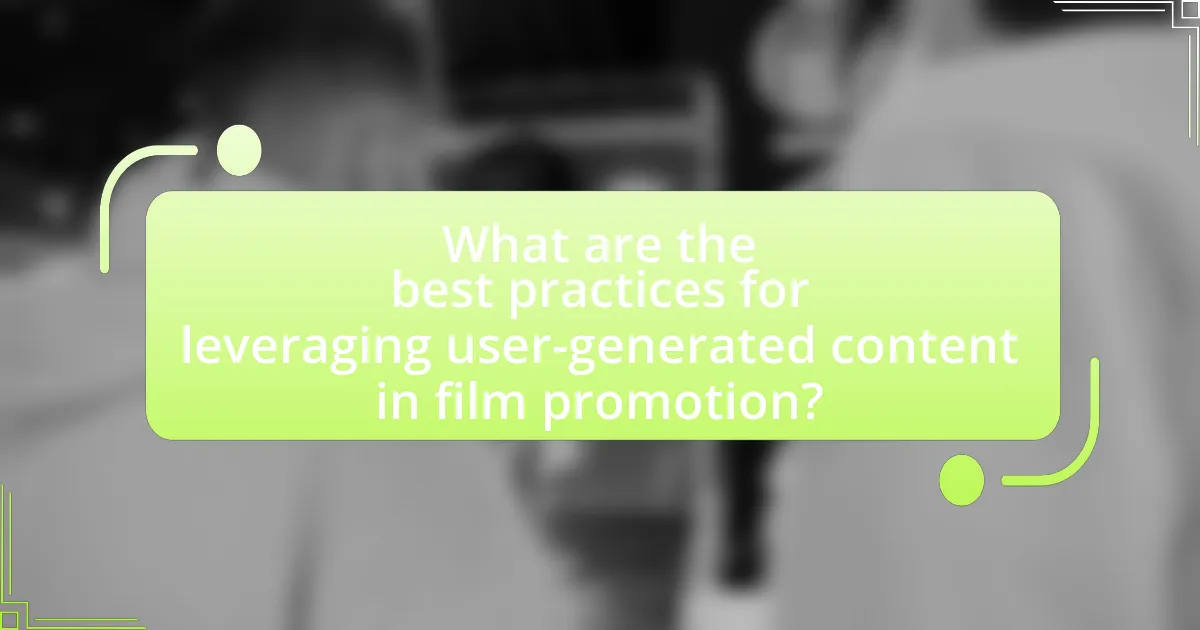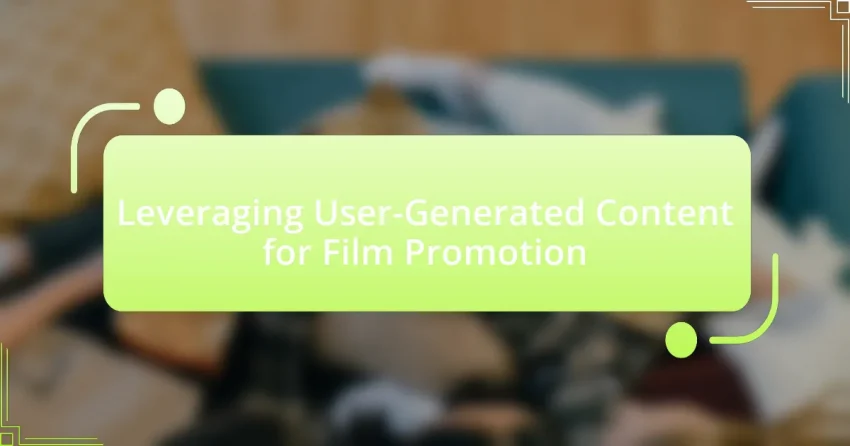Leveraging user-generated content (UGC) for film promotion involves utilizing content created by fans to enhance marketing efforts, fostering authentic engagement and community building. This strategy has proven effective, as seen in successful campaigns like “The Blair Witch Project,” where audience involvement significantly increased interest and viewership. The article explores how UGC enhances film promotion through increased audience engagement, the types of content that are most effective, and the importance of authenticity in building brand loyalty. It also addresses challenges filmmakers face, such as quality control and copyright issues, while providing strategies for encouraging and integrating UGC into marketing campaigns. Additionally, the article discusses future trends and the impact of technology on user-generated content in film marketing.

What is Leveraging User-Generated Content for Film Promotion?
Leveraging user-generated content for film promotion involves utilizing content created by fans or audiences to enhance marketing efforts. This strategy capitalizes on authentic engagement, as user-generated content often resonates more with potential viewers than traditional advertising. For instance, films like “The Blair Witch Project” successfully used fan-created content to build hype, demonstrating that audience involvement can significantly increase interest and viewership.
How does user-generated content enhance film promotion?
User-generated content enhances film promotion by increasing audience engagement and building community around the film. When fans create and share their own content, such as reviews, fan art, or social media posts, it generates organic buzz and authentic word-of-mouth marketing. According to a study by Nielsen, 92% of consumers trust user-generated content more than traditional advertising, which demonstrates its effectiveness in influencing potential viewers. This trust leads to higher conversion rates, as audiences are more likely to watch a film recommended by their peers. Additionally, user-generated content fosters a sense of ownership among fans, encouraging them to participate in the film’s promotional efforts and share their enthusiasm across various platforms.
What types of user-generated content are most effective for film marketing?
The most effective types of user-generated content for film marketing include fan art, reviews, social media posts, and video content such as trailers or reaction videos. Fan art engages the community and showcases creativity, while reviews provide authentic opinions that can influence potential viewers. Social media posts, particularly those that use hashtags related to the film, increase visibility and encourage sharing among audiences. Video content, including trailers created by fans or reaction videos, can generate excitement and foster a sense of community around the film. Research indicates that user-generated content can increase engagement rates by up to 28% and enhance brand trust, making it a powerful tool in film marketing strategies.
How does user-generated content influence audience engagement?
User-generated content significantly enhances audience engagement by fostering a sense of community and authenticity. When audiences create and share their own content related to a film, it encourages interaction and participation, leading to increased emotional investment in the film. Research indicates that 79% of consumers say user-generated content highly impacts their purchasing decisions, demonstrating its effectiveness in engaging audiences. Additionally, platforms that showcase user-generated content often experience higher levels of user interaction, as seen in campaigns where films encourage fans to share their experiences, resulting in a 50% increase in social media engagement metrics.
Why is user-generated content important in the film industry?
User-generated content is important in the film industry because it enhances audience engagement and builds community around films. This type of content allows fans to share their interpretations, reviews, and creative expressions related to films, which can significantly amplify marketing efforts. For instance, a study by the American Psychological Association found that user-generated content can increase brand loyalty by 28%, demonstrating its effectiveness in fostering a dedicated viewer base. Additionally, platforms like social media enable filmmakers to reach wider audiences through organic sharing, making user-generated content a vital tool for promoting films and creating buzz prior to release.
What role does authenticity play in user-generated content?
Authenticity is crucial in user-generated content as it fosters trust and engagement among audiences. When users perceive content as genuine, they are more likely to connect with it, leading to increased sharing and interaction. Research indicates that 79% of consumers say user-generated content highly impacts their purchasing decisions, demonstrating that authenticity enhances credibility and influences behavior. This connection is particularly significant in film promotion, where authentic user experiences can amplify reach and resonate with potential viewers, ultimately driving interest and attendance.
How does user-generated content impact brand loyalty among film audiences?
User-generated content significantly enhances brand loyalty among film audiences by fostering a sense of community and engagement. When audiences create and share their own content related to a film, such as reviews, fan art, or social media posts, they feel a personal connection to the film and its brand. This connection is supported by research from the Journal of Marketing, which indicates that user-generated content increases consumer trust and perceived authenticity, leading to stronger emotional ties to the brand. Furthermore, a study by Nielsen found that 92% of consumers trust organic, user-generated content more than traditional advertising, reinforcing the idea that such content can effectively cultivate loyalty among film audiences.
What challenges are associated with leveraging user-generated content?
Leveraging user-generated content presents several challenges, including issues of quality control, copyright concerns, and brand alignment. Quality control is a significant challenge as user-generated content can vary widely in quality, potentially harming a film’s reputation if subpar content is used. Copyright concerns arise when users create content that may inadvertently infringe on intellectual property rights, leading to legal complications. Additionally, ensuring that user-generated content aligns with the film’s branding and messaging is crucial; misalignment can confuse audiences and dilute the film’s marketing efforts. These challenges necessitate careful curation and management of user-generated content to effectively support film promotion.
How can filmmakers ensure quality in user-generated content?
Filmmakers can ensure quality in user-generated content by establishing clear guidelines and providing specific prompts for contributors. By outlining expectations regarding content style, length, and themes, filmmakers can guide users to create material that aligns with the film’s vision. For instance, a study by the Pew Research Center indicates that structured participation increases the likelihood of high-quality submissions, as contributors feel more empowered and informed about the desired outcome. Additionally, implementing a review process where submissions are vetted for quality before being used in promotional materials further enhances the overall standard of user-generated content.
What legal considerations should filmmakers be aware of when using user-generated content?
Filmmakers must obtain proper permissions and licenses when using user-generated content to avoid copyright infringement. User-generated content often contains copyrighted material, and using it without permission can lead to legal disputes and financial penalties. Additionally, filmmakers should consider the right of publicity, which protects individuals from unauthorized commercial use of their likeness or identity. This means obtaining consent from individuals featured in the content is essential. Furthermore, filmmakers should be aware of platform-specific terms of service, as these can dictate how user-generated content can be used. For instance, platforms like YouTube or Instagram have specific guidelines regarding the use of content uploaded by users, and violating these can result in content removal or account suspension.
How can filmmakers effectively encourage user-generated content?
Filmmakers can effectively encourage user-generated content by creating engaging campaigns that invite audience participation. For instance, they can launch contests or challenges on social media platforms, prompting fans to create and share their own content related to the film, such as fan art, videos, or reviews. A successful example is the “Star Wars: The Force Awakens” campaign, which encouraged fans to share their own stories and artwork, resulting in a significant increase in user-generated content and engagement. This approach not only fosters a sense of community but also amplifies the film’s reach through organic sharing, as users are more likely to promote content they have personally contributed to.
What strategies can be employed to integrate user-generated content into marketing campaigns?
Integrating user-generated content (UGC) into marketing campaigns can be effectively achieved through strategies such as social media contests, featuring customer testimonials, and creating branded hashtags. Social media contests encourage users to create and share content related to the brand, increasing engagement and visibility; for instance, a film promotion campaign could invite fans to submit their own movie posters or fan art. Featuring customer testimonials in marketing materials builds trust and authenticity, as studies show that 79% of consumers trust online reviews as much as personal recommendations. Creating branded hashtags allows users to easily share their content while also enabling the brand to track engagement and participation, enhancing community involvement. These strategies not only foster a sense of community but also leverage the authenticity of user-generated content to enhance brand credibility and reach.

What are the best practices for leveraging user-generated content in film promotion?
The best practices for leveraging user-generated content in film promotion include encouraging audience participation, showcasing authentic fan experiences, and utilizing social media platforms effectively. Encouraging audience participation can be achieved through contests or challenges that invite fans to create and share their content related to the film, which fosters community engagement and excitement. Showcasing authentic fan experiences, such as testimonials or behind-the-scenes footage shared by viewers, enhances credibility and relatability, making the film more appealing to potential audiences. Utilizing social media platforms effectively involves strategically sharing user-generated content across channels, engaging with fans through comments and shares, and using relevant hashtags to increase visibility. These practices have been shown to enhance audience connection and drive interest, as evidenced by campaigns like the “Star Wars: The Force Awakens” fan art initiative, which generated significant buzz and engagement prior to the film’s release.
How can social media platforms be utilized for user-generated content?
Social media platforms can be utilized for user-generated content by encouraging users to create and share their own content related to films, such as reviews, fan art, and videos. This approach enhances audience engagement and fosters a sense of community among fans. For instance, platforms like Instagram and TikTok allow users to post creative interpretations of film themes, which can lead to increased visibility and organic promotion of the film. According to a study by the Pew Research Center, 72% of teens use Instagram, making it a prime platform for reaching younger audiences through user-generated content. Additionally, campaigns that incentivize users to share their content, such as contests or hashtags, can significantly amplify reach and engagement, driving more conversations around the film.
What are the most effective social media strategies for film promotion?
The most effective social media strategies for film promotion include leveraging user-generated content, engaging with audiences through interactive posts, and utilizing targeted advertising. User-generated content, such as fan art or reviews, fosters community involvement and enhances authenticity, which can lead to increased audience interest. Engaging with audiences through polls, Q&A sessions, and live streams creates a two-way communication channel, making fans feel valued and connected to the film. Targeted advertising on platforms like Facebook and Instagram allows filmmakers to reach specific demographics, maximizing the impact of promotional efforts. According to a study by the American Film Institute, films that actively engage audiences on social media see a 30% increase in box office revenue compared to those that do not.
How can filmmakers create engaging campaigns that inspire user-generated content?
Filmmakers can create engaging campaigns that inspire user-generated content by leveraging interactive and relatable themes that resonate with their target audience. By incorporating social media challenges, contests, and hashtags, filmmakers encourage fans to share their own content related to the film, fostering a sense of community and participation. For instance, the “Ice Bucket Challenge” effectively utilized user engagement to raise awareness for ALS, demonstrating the power of participatory campaigns. Additionally, providing clear guidelines and incentives, such as exclusive content or recognition, can motivate users to contribute creatively, enhancing the overall promotional impact.
What metrics should be used to measure the success of user-generated content in film promotion?
The metrics used to measure the success of user-generated content in film promotion include engagement rate, reach, conversion rate, sentiment analysis, and shareability. Engagement rate quantifies interactions such as likes, comments, and shares, indicating how well the content resonates with the audience. Reach measures the total number of unique viewers exposed to the content, reflecting its visibility. Conversion rate tracks the percentage of users who take a desired action, such as purchasing tickets or visiting the film’s website, demonstrating the content’s effectiveness in driving action. Sentiment analysis evaluates the emotional tone of user-generated content, providing insights into audience perception. Shareability assesses how often the content is shared across platforms, indicating its viral potential. These metrics collectively provide a comprehensive view of the impact and effectiveness of user-generated content in promoting films.
How can audience feedback be analyzed to improve future campaigns?
Audience feedback can be analyzed through various methods such as surveys, social media monitoring, and sentiment analysis to improve future campaigns. By collecting quantitative data from surveys, filmmakers can gauge audience preferences and satisfaction levels, while social media monitoring allows for real-time insights into audience reactions and engagement. Sentiment analysis, which utilizes natural language processing techniques, can quantify the emotional tone of audience comments and reviews, providing a deeper understanding of public perception. For instance, a study by the American Marketing Association found that brands that actively analyze customer feedback can increase campaign effectiveness by up to 30%. This data-driven approach enables filmmakers to tailor their promotional strategies, ensuring they resonate more effectively with target audiences in future campaigns.
What tools can filmmakers use to track user-generated content engagement?
Filmmakers can use tools like Google Analytics, Hootsuite, and Sprout Social to track user-generated content engagement. Google Analytics allows filmmakers to monitor website traffic and user interactions with content, providing insights into how audiences engage with user-generated material. Hootsuite enables tracking of social media interactions, allowing filmmakers to analyze engagement metrics across various platforms. Sprout Social offers comprehensive analytics for social media, helping filmmakers understand audience sentiment and engagement levels with user-generated content. These tools provide concrete data that filmmakers can leverage to enhance their promotional strategies.

What future trends can be expected in user-generated content for film promotion?
Future trends in user-generated content for film promotion will likely include increased integration of interactive formats, such as augmented reality (AR) experiences and live-streamed events, which engage audiences more deeply. As social media platforms evolve, filmmakers will harness these technologies to create immersive promotional campaigns that encourage audience participation. For instance, a study by the Interactive Advertising Bureau found that 70% of consumers are more likely to engage with brands that utilize AR in their marketing strategies. Additionally, the rise of short-form video content, particularly on platforms like TikTok, will drive filmmakers to encourage fans to create and share their own content, amplifying reach and engagement. This trend aligns with the growing consumer preference for authentic, relatable content over traditional advertising, as evidenced by a survey from Stackla, which revealed that 79% of people say user-generated content highly impacts their purchasing decisions.
How is technology shaping the future of user-generated content in film marketing?
Technology is significantly shaping the future of user-generated content in film marketing by enabling more interactive and personalized engagement between audiences and filmmakers. Advanced social media platforms and mobile applications allow users to create, share, and promote content related to films, fostering a community-driven marketing approach. For instance, platforms like TikTok and Instagram have become essential tools for film promotion, where users can generate buzz through creative videos and challenges, leading to increased visibility and audience reach. According to a 2022 report by the Interactive Advertising Bureau, 79% of marketers believe that user-generated content is an effective way to engage consumers, highlighting its growing importance in marketing strategies. This shift towards user-generated content not only enhances authenticity but also allows filmmakers to tap into diverse perspectives, ultimately shaping the narrative around their films.
What emerging platforms are likely to influence user-generated content strategies?
Emerging platforms likely to influence user-generated content strategies include TikTok, Discord, and Clubhouse. TikTok’s short-form video format encourages creative expression and virality, making it a powerful tool for film promotion as users create content around movie themes or challenges. Discord facilitates community engagement through its chat and voice channels, allowing fans to discuss films and share content in real-time, enhancing user interaction. Clubhouse, with its audio-based discussions, enables filmmakers and fans to engage in live conversations, fostering a deeper connection and generating buzz around upcoming films. These platforms are reshaping how audiences interact with content, driving innovative user-generated strategies in film promotion.
How can filmmakers adapt to changing audience behaviors regarding user-generated content?
Filmmakers can adapt to changing audience behaviors regarding user-generated content by actively engaging with audiences on social media platforms and incorporating user-generated content into their marketing strategies. This approach allows filmmakers to tap into the authenticity and relatability that user-generated content offers, which resonates with modern audiences who prefer genuine interactions over traditional advertising. For instance, a study by the Content Marketing Institute found that 79% of consumers say user-generated content highly impacts their purchasing decisions, highlighting its effectiveness in film promotion. By encouraging fans to create and share content related to their films, filmmakers can foster community engagement and enhance their promotional efforts.
What practical tips can filmmakers follow to maximize user-generated content effectiveness?
Filmmakers can maximize user-generated content effectiveness by actively engaging their audience and creating clear guidelines for content creation. Engaging with the audience fosters a sense of community and encourages participation, as seen in campaigns like the “Ice Bucket Challenge,” which generated millions of user videos. Providing specific guidelines helps ensure that the content aligns with the film’s branding and messaging, increasing the likelihood of sharing and visibility. For instance, the “Star Wars: The Force Awakens” campaign successfully encouraged fans to create and share their own content by offering prompts and themes, resulting in a significant increase in user engagement and content quality.
